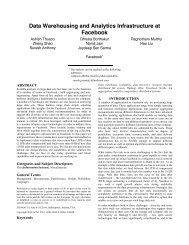Data Warehousing and Analytics Infrastructure at Facebook
Data Warehousing and Analytics Infrastructure at Facebook
Data Warehousing and Analytics Infrastructure at Facebook
Create successful ePaper yourself
Turn your PDF publications into a flip-book with our unique Google optimized e-Paper software.
<strong>D<strong>at</strong>a</strong> <strong>Warehousing</strong> <strong>and</strong> <strong>Analytics</strong><br />
<strong>Infrastructure</strong> <strong>at</strong> <strong>Facebook</strong><br />
Ashish Thusoo & Dhruba Borthakur<br />
<strong>at</strong>husoo,dhruba@facebook.com
Overview<br />
Challenges in a Fast Growing & Dynamic Environment<br />
<strong>D<strong>at</strong>a</strong> Flow Architecture, Applic<strong>at</strong>ions & Middleware<br />
Backend <strong>Infrastructure</strong> Challenges & Usage St<strong>at</strong>istics<br />
Conclusion
Key Challenge (I)<br />
<strong>D<strong>at</strong>a</strong>, d<strong>at</strong>a <strong>and</strong> more d<strong>at</strong>a<br />
Recent Growth of <strong>D<strong>at</strong>a</strong> for Analysis <strong>at</strong> <strong>Facebook</strong> (TB of d<strong>at</strong>a)
Key Challenge (II)<br />
Accessibility<br />
Simplify d<strong>at</strong>a access <strong>and</strong> use prevalent <strong>and</strong> familiar tools<br />
Make d<strong>at</strong>a available as soon as possible
Key Challenge (III)<br />
Flexibility<br />
Support for different d<strong>at</strong>a form<strong>at</strong>s<br />
Support for user defined comput<strong>at</strong>ions <strong>and</strong> extensions<br />
Ability to evolve with d<strong>at</strong>a
Technologies<br />
Hadoop – Scalable Storage <strong>and</strong> Compute Grid<br />
Hive, coHive & HiPal – Extensible & Flexible <strong>D<strong>at</strong>a</strong><br />
<strong>Warehousing</strong> Framework the provides SQL like Query<br />
Language on Hadoop<br />
Scribe-HDFS – Scalable Log Collection <strong>Infrastructure</strong><br />
Nectar – Flexible Instrument<strong>at</strong>ion Framework<br />
<strong>D<strong>at</strong>a</strong>bee & Chronos – Dependency based Scheduling<br />
<strong>Infrastructure</strong>
<strong>D<strong>at</strong>a</strong> Flow Architecture <strong>at</strong> <strong>Facebook</strong><br />
Web Servers <br />
Scribe-‐Hadoop Cluster <br />
Hive <br />
replicaDon <br />
SILVER Hive-‐Hadoop Cluster <br />
Oracle RAC <br />
PLATINUM Hive-‐Hadoop Cluster <br />
Feder<strong>at</strong>ed MySQL
Usage<br />
Types of Applic<strong>at</strong>ions:<br />
– Reporting<br />
Eg: Daily/Weekly aggreg<strong>at</strong>ions of impression/click counts<br />
Measures of user engagement<br />
Microstr<strong>at</strong>egy reports<br />
– Ad hoc Analysis<br />
Eg: how many group admins broken down by st<strong>at</strong>e/country<br />
– Machine Learning (Assembling training d<strong>at</strong>a)<br />
Ad Optimiz<strong>at</strong>ion<br />
Eg: User Engagement as a function of user <strong>at</strong>tributes<br />
– Index Gener<strong>at</strong>ion etc.
Analysis <strong>and</strong> <strong>D<strong>at</strong>a</strong> Organiz<strong>at</strong>ion<br />
> 99% of analysis through Hive on Hadoop<br />
Hive:<br />
– Easy to use: Familiar SQL interface with <strong>D<strong>at</strong>a</strong> as Tables <strong>and</strong><br />
Columns)<br />
– Easy to extend:<br />
Can embed map/reduce user programs in the d<strong>at</strong>a flow<br />
Support for user defined functions<br />
– Flexible:<br />
Supports user defined d<strong>at</strong>a form<strong>at</strong>s <strong>and</strong> storage form<strong>at</strong>s<br />
Support user defined types<br />
– Interoperable:<br />
JDBC, ODBC <strong>and</strong> thrift interfaces for integr<strong>at</strong>ion with BI tools
Applic<strong>at</strong>ion Instrument<strong>at</strong>ion (10,000 feet)<br />
1. Setup new scribe c<strong>at</strong>egory<br />
Class MyEvent :<br />
NectarAppEvent<br />
2. Copiers to copy d<strong>at</strong>a into warehouse<br />
3. Autom<strong>at</strong>ic cre<strong>at</strong>ion of tables in Hive<br />
_current <strong>and</strong> _r tables<br />
4. Autom<strong>at</strong>ic detection of schema changes<br />
MyEvent->log()<br />
5. Near real time event st<strong>at</strong>istics dashboard<br />
Nectar Framework Services
<strong>D<strong>at</strong>a</strong> Discovery (10,000 feet)<br />
1. Tag based search on Table Metad<strong>at</strong>a<br />
2. Crowd sourcing to gener<strong>at</strong>e tag inform<strong>at</strong>ion<br />
<strong>D<strong>at</strong>a</strong> Discovery<br />
3. Ability to ask questions from expert users<br />
th<strong>at</strong> are identified by analyzing usage logs<br />
4. Lineage inform<strong>at</strong>ion of d<strong>at</strong>a shown for browsing<br />
<strong>and</strong> d<strong>at</strong>a discovery<br />
coHive Services in HiPal
B<strong>at</strong>ch Jobs (10,000 feet)<br />
Builtin Oper<strong>at</strong>ors for Common Tasks<br />
Chaining<br />
Transform<strong>at</strong>ions<br />
Specific<strong>at</strong>ion for DAG of Transforms<br />
Smart retries <strong>and</strong> checkpointing on failures<br />
Chronos Scheduler<br />
Monitoring, Alerting<br />
& St<strong>at</strong>istics<br />
<strong>D<strong>at</strong>a</strong> Availability St<strong>at</strong>istics <strong>and</strong> Alerts<br />
Resource Utiliz<strong>at</strong>ion History<br />
<strong>D<strong>at</strong>a</strong>Bee & Chronos Services
Hadoop & Hive Cluster @ <strong>Facebook</strong><br />
Hadoop/Hive cluster<br />
– 16000 cores<br />
– Raw Storage capacity ~ 21PB<br />
– 8 cores + 12 TB per node<br />
– 32 GB RAM per node<br />
– Two level network topology<br />
1 Gbit/sec from node to rack switch<br />
10 Gbit/sec to top level rack switch<br />
2 clusters<br />
– One for adhoc users (SILVER cluster)<br />
– One for strict SLA jobs (PLATINUM cluster)
Hive & Hadoop Usage @ <strong>Facebook</strong><br />
St<strong>at</strong>istics per day:<br />
– 800TB of I/O per day<br />
– 10K – 25K Hadoop jobs per day<br />
Hive simplifies Hadoop:<br />
– New engineers go though a Hive training session<br />
– Analysts (non-engineers) use Hadoop through Hive<br />
– Most of jobs are Hive Jobs
<strong>D<strong>at</strong>a</strong> Collection <strong>and</strong> Real time Availability<br />
Challenge: Large Volume of d<strong>at</strong>a to be queryable as soon<br />
as it is produced:<br />
– Logs produce 100 TB per day uncompressed<br />
– Store in Scribe-HDFS clusters co-loc<strong>at</strong>ed with web-tier<br />
Query-able within 15 seconds (via tail –f )<br />
Overlapping HDFS clusters to avoid Single Point of Failure<br />
Two separ<strong>at</strong>e NameNodes<br />
Two <strong>D<strong>at</strong>a</strong>Node instances on same physical machine<br />
– Gzip compressed, uploaded into central warehouse<br />
Query-able within 15 minutes (via Hive external tables)
Scribe-HDFS: Near Real Time Log Collection<br />
Scribe<br />
– An Open Source Technology cre<strong>at</strong>ed <strong>at</strong> <strong>Facebook</strong> for Log Collection<br />
– Routes log messages from source (web machines) to destin<strong>at</strong>ion<br />
storage<br />
– Persistently buffers d<strong>at</strong>a on intermedi<strong>at</strong>e nodes to deal with<br />
failures<br />
Scribe-HDFS<br />
– A highly scalable routing service + a highly scalable storage service<br />
– Enables us to scale with commodity nodes – no more expensive<br />
filers
Scribe-HDFS: 101<br />
Scribed<br />
HDFS<br />
<strong>D<strong>at</strong>a</strong> Node<br />
Scribed<br />
<br />
Scribed<br />
Append to<br />
/staging//<br />
HDFS<br />
<strong>D<strong>at</strong>a</strong> Node<br />
Scribed<br />
Scribed<br />
HDFS<br />
<strong>D<strong>at</strong>a</strong> Node<br />
Scribe-HDFS
Warehouse is Business Critical<br />
Challenge: Remove all single points of failure (SPOF)<br />
Hadoop NameNode was a SPOF<br />
Hadoop Av<strong>at</strong>arNode<br />
– Active-passive Hot St<strong>and</strong>by pair of NameNodes<br />
– Failover time for 20 PB file system having 65 million files is 10<br />
seconds<br />
– Work-in progress to support active-active Av<strong>at</strong>arNode
Warehouse Utiliz<strong>at</strong>ion <strong>and</strong> Workload<br />
Compute Map-Reduce cluster is CPU bound<br />
– Peak usage of 95% CPU utiliz<strong>at</strong>ion<br />
– Peak network usage is 70% (network is not a bottleneck)<br />
– 70% tasks find d<strong>at</strong>a on local rack<br />
– We do not compress map outputs<br />
Storage HDFS cluster is capacity bound<br />
– 75% storage full (current size is 21 PB, 2000 nodes)<br />
– Disk b<strong>and</strong>width used is 20% of capacity (IO is not a bottleneck)<br />
– All Hive tables compressed using gzip
Hive: Optimizing Resource Utiliz<strong>at</strong>ion<br />
Joins:<br />
– Joins try to reduce the number of map/reduce jobs needed.<br />
– Memory efficient joins by streaming largest tables.<br />
– Map Joins<br />
User specified small tables stored in hash tables on the mapper<br />
No reducer needed<br />
Aggreg<strong>at</strong>ions:<br />
– Map side partial aggreg<strong>at</strong>ions<br />
Hash-based aggreg<strong>at</strong>es<br />
Serialized key/values in hash tables<br />
– 90% speed improvement on Query<br />
SELECT count(1) FROM t;<br />
– Load balancing for d<strong>at</strong>a skew
Storage Costs<br />
Challenge: disk is cheap, but the cost of PetaBytes of<br />
disk is huge!<br />
HDFS-RAID<br />
– Default policy for HDFS is to replic<strong>at</strong>e d<strong>at</strong>a 3 times<br />
– Gener<strong>at</strong>e parity block from a stripe of blocks from a file<br />
– HDFS-RAID replic<strong>at</strong>es d<strong>at</strong>a 2 times <strong>and</strong> keeps parity blocks<br />
– Saves around 25% disk space<br />
Columnar Compression<br />
– Hive RCFile form<strong>at</strong> organizes content by column<br />
– Saves around 15-25% of disk space
Single Warehouse for Adhoc <strong>and</strong> Periodic jobs<br />
Challenge: support adhoc <strong>and</strong> periodic jobs in a single<br />
instance of the warehouse<br />
– New job arrives every 10 seconds<br />
– 90% jobs are small <strong>and</strong> finish within a few minutes<br />
– Users run lots of experiments to mine d<strong>at</strong>a<br />
– B<strong>at</strong>ch processing for large hourly/daily/weekly reporting<br />
– 99% uptime<br />
Hadoop Map-Reduce FairShare Scheduler<br />
– Each user gets an equal share of the cluster<br />
– Optimize l<strong>at</strong>ency for small jobs<br />
– Optimize cluster utiliz<strong>at</strong>ion <strong>and</strong> fair-share for larger jobs<br />
– Resource aware scheduling (CPU <strong>and</strong> memory resources only)
Isol<strong>at</strong>ion for Business Critical Pipelines<br />
Challenge: 100% uptime for a select set of pipeline<br />
Separ<strong>at</strong>e a small storage & compute cluster<br />
– PLATINUM cluster<br />
– Small subset of d<strong>at</strong>a from production warehouse<br />
– No adhoc queries<br />
– High bar for gradu<strong>at</strong>ing a pipeline from production warehouse to<br />
PLATINUM warehouse<br />
– Poor man’s Disaster Recovery Solution (DR)<br />
– 99.9% uptime SLA<br />
Hive replic<strong>at</strong>ion<br />
– Scribe copies d<strong>at</strong>a into PLATINUM<br />
– Copier looks <strong>at</strong> Hive query logs to replic<strong>at</strong>e d<strong>at</strong>a from PLATINUM to<br />
SILVER cluster
Conclusion<br />
Scalable, Accessible & Flexible infrastructure a MUST<br />
Use & Contribute to Open Source to keep the costs low<br />
– Hadoop<br />
– Hive<br />
– Scribe-HDFS<br />
Always a challenge to keep up with a dynamically growing<br />
& changing environment




